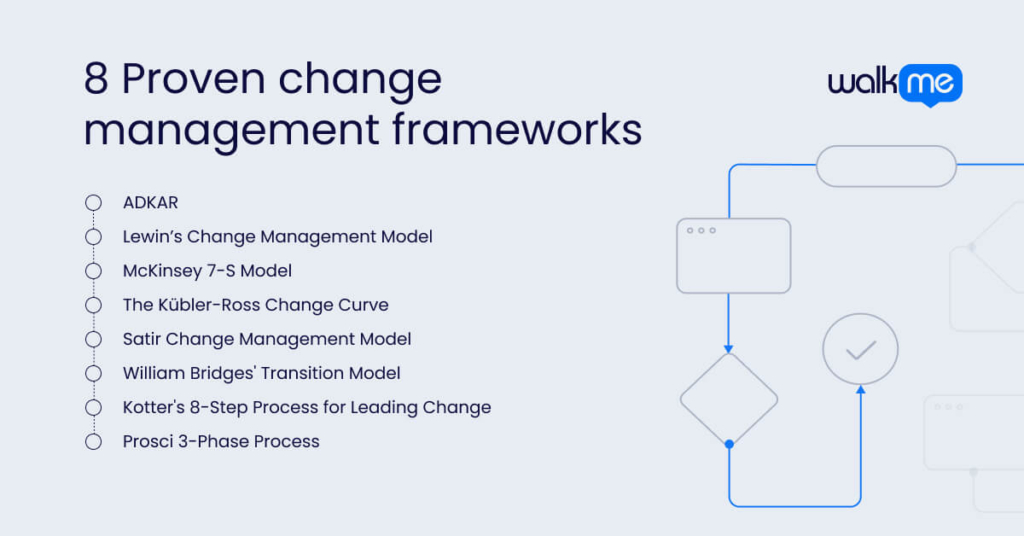Organizations must adapt quickly to retain their competitive advantage in an era of rapid market shifts and technological advancements.
Change management frameworks offer structured methods to guide companies through these transitions effectively. These methodologies provide systematic processes for implementing organizational changes, minimizing disruption, and maximizing employee adoption rates.
This article will explore the top eight change management frameworks of 2024 to give you a comprehensive understanding of the most effective strategies for navigating organizational change.

- ADKAR
ADKAR breaks down change into five key elements: Awareness, Desire, Knowledge, Ability, and Reinforcement.
This granular approach allows organizations to pinpoint specific barriers to change adoption. In an era where employee buy-in can make or break initiatives, ADKAR’s focus on individual change readiness is particularly valuable.
The model excels in situations requiring widespread behavioral shifts, such as adopting new technologies or processes. Its strength lies in its adaptability—it can be applied to both large-scale organizational changes and smaller departmental shifts.
ADKAR’s emphasis on reinforcement addresses a common pitfall in change management: the tendency for people to revert to old habits once the initial push for change subsides. By providing a clear framework for sustained change, ADKAR helps organizations avoid the costly cycle of implementing changes only to see them fade away months later.
This long-term focus makes it particularly relevant in industries undergoing continuous transformation.
- Lewin’s Change Management Model
Lewin’s Change Management Model, with its three stages—Unfreeze, Change, and Refreeze—offers a deceptively simple framework that belies its power in practice.
The “Unfreeze” stage acknowledges an often-overlooked truth: old habits must be dismantled before new behaviors can take root. This stage is crucial in overcoming organizational inertia, particularly in long-established companies facing disruptive market forces.
The “Change” phase provides a structured approach to implementing new processes, allowing experimentation and adjustment. In today’s business environment, where agility is prized, this stage can be extended to foster a culture of continuous improvement.
The “Refreeze” stage, often misinterpreted as a return to rigidity, emphasizes the importance of consolidating gains and preventing regression. This balance between flexibility and stability makes Lewin’s model particularly relevant for organizations navigating the tension between innovation and operational efficiency.
- McKinsey 7-S Model
The McKinsey 7-S Model stands out for its holistic approach. It recognizes that effective change requires alignment across seven interdependent factors: Strategy, Structure, Systems, Shared Values, Style, Staff, and Skills.
This multidimensional view is particularly valuable in today’s interconnected business landscape, where a change in one area can have unforeseen consequences in another. The model’s inclusion of “soft” elements like Shared Values alongside “hard” factors like Strategy addresses a critical oversight in many change initiatives—the role of organizational culture.
This makes it especially useful in mergers, where cultural integration is often the make-or-break factor.
The 7-S framework is also a powerful diagnostic tool, helping leaders identify misalignments hindering performance. Its comprehensive nature makes it well-suited for complex, large-scale transformations where a narrow focus on just one or two elements will likely fall short.
- The Kübler-Ross Change Curve
The Kübler-Ross Change Curve offers valuable insights into the emotional journey of organizational change.
Its five stages—Denial, Anger, Bargaining, Depression, and Acceptance—map closely to the emotional responses often observed during major organizational shifts.
The model’s strength lies in its recognition that resistance to change is not a simple obstacle to overcome but a complex emotional process to navigate. This understanding is particularly crucial in job losses or significant role changes.
The model’s limitations should also be noted—not everyone will experience all stages or in the same order.
However, its framework provides a valuable starting point for developing emotionally intelligent change management strategies, particularly in high-stakes situations where employee buy-in is critical.
- Satir Change Management Model
The Satir model, with its stages of Late Status Quo, Resistance, Chaos, Integration, and New Status Quo, offers a nuanced view of the change process that acknowledges its non-linear nature.
Unlike models that present change as a smooth, predictable progression, Satir recognizes the messy reality of organizational transformation. The model’s “Chaos” stage is particularly insightful, acknowledging that a period of confusion and reduced performance is often unavoidable in significant change.
This recognition can help leaders set realistic expectations and plan accordingly rather than panicking when initial results don’t meet projections.
The “Integration” stage highlights the importance of learning and adaptation in the change process, making this model particularly relevant in industries where innovation and continuous improvement are key.
- William Bridges’ Transition Model
Bridges’ model distinguishes itself by focusing on the psychological process of transition rather than the logistical aspects of change.
Its three phases—Ending, Neutral Zone, and New Beginning—provide a framework for understanding the human side of organizational shifts.
The change management methodology’s emphasis on the “Ending” phase is particularly insightful. It recognizes that people must acknowledge and mourn what they’re leaving behind before fully embracing something new.
This is especially relevant in mergers, restructures, or significant cultural shifts. The concept of the “Neutral Zone” as a period of psychological realignment offers a fresh perspective on why change initiatives often stall midway.
By reframing this challenging period as a necessary part of the process, leaders can better support their teams through it. The model’s focus on psychological transition makes it particularly valuable in change scenarios where technical implementation is straightforward, but human adaptation is the primary challenge.
- Kotter’s 8-Step Process for Leading Change
Kotter’s change model stands out for its practical, action-oriented approach to large-scale organizational change. Its eight steps—from creating a sense of urgency to anchoring new approaches in the culture—provide a clear roadmap for leaders navigating complex transformations.
The model’s emphasis on building a guiding coalition and creating short-term wins addresses two critical factors often overlooked in change initiatives: broad-based support and maintaining momentum.
Kotter’s focus on communication—articulating a vision and celebrating progress—is particularly relevant in today’s information-rich environments where competing messages can easily drown out change initiatives.
The model’s later steps, which focus on consolidating gains and institutionalizing change, address the common pitfall of declaring victory too soon. This long-term perspective makes Kotter’s approach particularly valuable for fundamental shifts in organizational strategy or culture, where sustained effort is required to prevent regression to old ways of working.
- Prosci 3-Phase Process
The Prosci 3-Phase Process offers a comprehensive, research-based approach to change management that bridges individual and organizational perspectives.
Its phases—Prepare Approach, Manage Change, and Sustain Outcomes—provide a structured methodology that complements the individual focus of the ADKAR model.
The “Prepare Approach” phase stands out for its emphasis on customizing change strategies to the specific organizational context, recognizing that off-the-shelf solutions often fall short.
The “Manage Change” phase integrates the ADKAR model, providing a granular approach to guiding individuals through transition. This combination of organizational and individual perspectives makes the Prosci approach particularly effective for complex, multi-layered changes such as digital transformations.
The “Sustain Outcomes” phase addresses a common blind spot in many change initiatives—the need for ongoing reinforcement and measurement to ensure changes stick.
This long-term focus makes the Prosci approach especially relevant in industries where the pace of change is relentless, and the ability to embed new practices quickly is a competitive advantage.
Creating a synergy with change management frameworks
Change management frameworks are essential roadmaps in the complex terrain of organizational transformation.
Each framework we’ve examined—from ADKAR to Prosci, Lewin to Kotter—offers a unique lens to view and navigate change. These frameworks aren’t competing methodologies but complementary tools in a leader’s arsenal.
The true power of change management frameworks lies in their synergistic application. Savvy organizations recognize that different phases of transformation may call for different approaches.
They might use Lewin’s model to initiate change, ADKAR to guide individual transitions, and McKinsey’s 7-S to ensure comprehensive alignment. Leaders can craft more nuanced, effective change strategies by understanding the strengths and contexts of various frameworks. Today, mastery of these frameworks isn’t just about managing isolated changes—it’s about building an organization that can adapt swiftly and sustainably to whatever challenges arise.

FAQs
A change management framework is a structured approach used by organizations to plan, implement, and control changes effectively. It provides a roadmap for transitioning individuals, teams, and entire companies from their current state to a desired future state.
These frameworks typically include steps for identifying the need for change, planning the change process, communicating with stakeholders, implementing the change, supporting people through the transition, and measuring and reinforcing the change.
The four pillars of change management are:
- Leadership Alignment: Ensuring leaders are united in supporting the change.
- Stakeholder Engagement: Involving and communicating with all affected parties.
- Communication: Maintaining clear, consistent messaging throughout the change process.
- Training and Support: Providing necessary skills and resources for employees to adapt to the change.
These pillars form the foundation for successful organizational change implementation.
Kotter’s 8-Step Process, developed by John Kotter, is widely regarded as the most popular change management model. It provides a comprehensive approach to implementing organizational change.
Its popularity stems from its clear, step-by-step methodology and focus on preparing and motivating people to change. The model’s emphasis on creating a sense of urgency and building a guiding coalition resonates with many organizations facing significant transformations.

